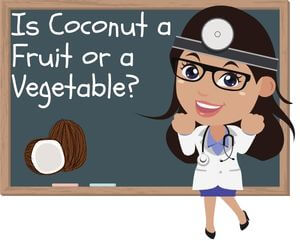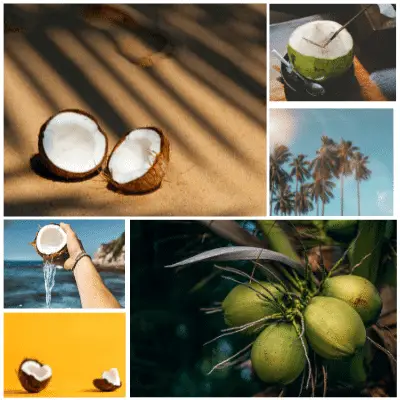Since the coconut can swim several thousand kilometers in the ocean and is still capable of germination afterward, the original region of origin of the coconut is no longer traceable today. It’s probably Malaysia, Polynesia, or Central America. What is certain is that the coconut has been valued as food in India for over 2,000 years.
Today coconuts are grown in numerous countries along the equator, such as India, Indonesia, the Philippines, Sri Lanka, Malaysia, and Thailand.

The coconut is harvested immaturely as a triangular, slightly larger than head-sized fruit. To save transport volume, the green, light brown, or yellow outer layer and the underlying fiber layer of the coconut are removed in the growing countries. Only round to egg-shaped nuts with a 20 to 30 cm length and a 0.9 to 2.5 kg weight reaches the market.
The shell of the coconut is rock-hard and about 5 mm thick, and covered with a remnant of fibers. Under the peel is the white, firm, and fibrous, aromatic-tasting pulp with a thickness of about 1 to 2 cm.
In the hollow core of the coconut, there is sweetish, almost clear liquid called coconut water, which decreases as the coconut ripens. The coconut water of an undamaged coconut is germ-free and can be drunk without hesitation. It is a crucial thirst quencher in many growing countries and often a substitute for scarce drinking water.
Is the coconut a fruit or a vegetable? Yes! The coconut is the fruit of the coconut palm and is one of the … well, what? Right, stone fruits! This means that coconuts are related to cherries, peaches, and mangoes – and not, as the name suggests, to hazelnuts and walnuts.
Which Fruit Is A Coconut?
From a botanical perspective, the coconut is a stone fruit and is one of the enormous fruits in the plant kingdom. It becomes about a foot long, 25 centimeters wide, weighs up to 2500 grams, and a green shell surrounds the egg-shaped, single-seeded fruit. Underneath, there is a first fleshy, then fibrous layer several centimeters thick.
The core has a rugged, woody shell. It is hollow and, when immature, is filled with a clear liquid, coconut water. The fluid becomes more petite as it ripens, and a one to two-centimeter-thick fleshy layer grows in the stone core. It is the pulp of the coconut.
Why Is The Coconut Actually So Healthy?
- Coconut is healthy because it contains healthy fatty acids: A coconut consists of 36 percent fats, mainly saturated fatty acids. In addition to caprylic and capric acid, coconut contains a large proportion of lauric acid. This has a particularly positive effect on the immune system because the antimicrobial and antiviral effect of lauric acid frees the body from numerous pathogens. In contrast to animal fat, the fats in coconuts are medium-chain rather than long. The so-called medium-chain triglycerides (MCD) can be broken down by the body relatively quickly and prevent food cravings. Since this is not stored as body fat but instead is immediately converted into energy, it is a great help in losing weight. Another reason why coconut is so healthy is that it lowers cholesterol. The MTC is also responsible for this. They reduce both total cholesterol and LDL cholesterol. The perfect prerequisite for a healthy cardiovascular system
- Coconut is healthy because it is high in fiber: In addition to healthy fats, fiber is also a big part of the coconut. These are important in keeping the intestinal tract healthy and preventing constipation. The fiber in a coconut not only promotes digestion it is also a great help in losing weight. They also protect against diabetes and lower blood sugar levels in the body. Good-to-know: Just one cup of coconut meat already contains 7 grams of fiber
- Coconut is healthy because it is high in copper: The coconut also plays a major role in brain function. The high copper content in the super food is responsible for activating enzymes. This promotes the formation of neurotransmitters, which are responsible for the exchange of information between the cells. Copper, therefore, helps stimulate brain function, which can, for example, stop Alzheimer’s disease. One portion of the meat is enough to cover 17 percent of the daily copper requirement.
- Coconut is healthy because it contains important minerals: Especially the coconut water inside the coconut is full of minerals such as potassium, calcium, sodium, iron, zinc, copper, phosphorus, and selenium. Especially after exercise, it is great for replenishing the mineral balance. In addition, coconut water is free from industrial sugar, sweeteners, and artificial flavors and is, therefore, a strong competitor to the iso drink. See more on Properties and Benefits of Coconuts

Is Coconut Meat Healthy?
Coconut meat is rich in potassium, contains about half as much protein as most nuts, and has an energy content of 360 kilocalories per 100 grams. Coconut butter also contains folic acid and other valuable B vitamins.
Is Coconut Milk Healthy?
Coconut milk is highly rich in nutrients, minerals, and vitamins. These include, in particular, potassium, sodium, iron, and magnesium. And since the coconut is naturally more of a fatty fruit, the coconut milk itself has around 20 percent fat. That means 50 milliliters contain 98.5 calories. However, creamy milk is a healthy and vegan alternative to cream. It has a lot of nutritional value and includes vegetables, not animal fats.
The fats in coconut are healthy fatty acids, namely triglycerides (neutral fats). The medium-chain fatty acids are digested quickly, converted into energy by the body, and serve as an essential resource.
See also :
How long can the coconut keep?
The green coconut stays fresh for about a week, while the brown coconut can be kept for three weeks. It would also be important how long the coconuts have been in business in most cases. The green coconuts should always be stored in the refrigerator, while the brown coconuts must be stored in a cool, dry place. The cool cellar is sufficient for this.
How do you recognize a lousy coconut?
As soon as you open the coconut, you will see the freshness of the tropical fruit. If the coconut water is already dehydrated, it is an old coconut. Even if the coconut water is already very cloudy and slimy, this indicates that the coconut is no longer fresh. You can also see the freshness very well by the smell and taste. Coconut water and coconut meat must not taste sour under any circumstances.
How can the shelf life of coconuts be extended?
You should always store the coconut unopened. If you want to open and keep the coconut, it is best to use up the coconut water or freeze it quickly. You can also freeze or dry the coconut meat. This also makes it very durable. The opened coconut must always be stored in the refrigerator and processed within three days.
How does a horrible coconut taste?
The coconut water and the coconut meat can taste sour or soapy. Usually, the buttery taste comes to the fore when the coconut water has dried out. Coconut meat can also taste rancid quickly because it is high in fat. Even if you think you have a moldy taste, you should not use the coconut anymore.
How long does a coconut take to ripen?
The older the coconut, the thicker and stiffer the coconut meat, as it is formed from coconut water. The ripe coconut is harvested between about the tenth to the twelfth month with an average weight of about 400 grams.
How long can you store a coconut?
A coconut that has been opened quickly loses its taste and freshness. You will feel this the very next day. You can use coconut in a closed plastic bag or vessel for three days to keep in the fridge. There was little oxygen as possible to come to the coconut meat.
Final Thought
The coconut is egg-shaped and can be between 10 and 20 cm long. The coconut is surrounded by a green and smooth outer skin, but it is not put on the market with this. After removing this skin, a thick, brown layer of fibers appears. The skin underneath is dark brown, dense, and complex. At the top of a coconut, there are three round spores. When the coconut germinates, the shoot appears from one of these pores. It is advisable to do the “shake test” when buying a coconut. The coconut milk must be audible inside the nut. If you don’t hear any gurgling, you can assume that the fruit has dried out and is therefore old and spoiled.
The pulp of the coconut can be eaten raw. It is also used in the growing countries to produce numerous desserts and sweets and cook hearty dishes. Dried coconut meat (called “copra”) is grated and used in confectionery and confectionery as desiccated coconut. Coconut oil or fat is also pressed from the copra. It also serves as the basis for making margarine and coconut paste.
The coconut water inside the coconut is a refreshing drink and serves as a water substitute on many islands with scarce water supplies or without drinking water sources. Three coconuts already cover the daily fluid requirement with an average content of around 1 liter of coconut water per coconut. The coconut water is often fermented into coconut wine.
